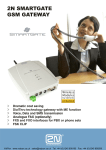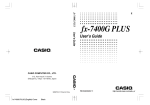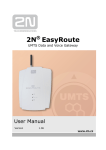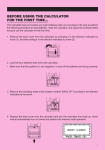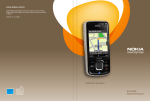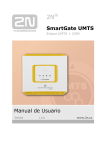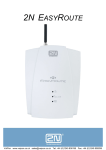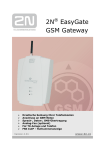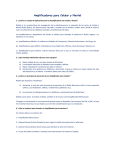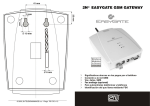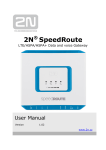Download EasyGate UMTS Data ENG 1.0
Transcript
Dear customer,
Let us congratulate you on having purchased the EasyGate UMTS Data system. This
new product has been developed and manufactured to provide the maximum utility
value, quality and reliability. We hope you will be fully satisfied with this UMTS/GSM
gateway for a long time. Therefore, use your EasyGate UMTS Data for purposes it has
been designed and manufactured for, in accordance herewith.
The manufacturer reserves the right to modify the product in order to improve its
qualities.
Safety Precautions
Do not switch on EasyGate UMTS Data in the vicinity of medical apparatuses to
avoid interference. The minimum distance of the antenna and pacemakers
should be 0.5 m.
Do not switch on EasyGate UMTS Data aboard of a plane.
Do not switch on EasyGate UMTS Data near petrol stations, chemical facilities or
sites where explosives are used.
Any mobile telephone use prohibition based on RF energy radiation applies to
EasyGate UMTS Data too.
EasyGate UMTS Data may disturb the function of TV sets, radio sets and PCs.
Warning! EasyGate UMTS Data contains components that can be swallowed by
small children (USIM card, antenna, etc.).
The voltage value mentioned on the adapter may not be exceeded. If you
connect EasyGate UMTS Data to another power supply, make sure that the
voltage value is in the acceptable range.
When your EasyGate UMTS Data comes to the end of its operational life,
dispose of it in accordance with applicable regulations.
User Manual Versions
Version
Amendments to Earlier Versions
1.00
• The User Manual applies to EasyGate UMTS Data FW Version 2.20K
Upgrade
The manufacturer continuously meets customer requirements by improving the
firmware. For the latest EasyGate UMTS Data processor firmware, programming tool
and User Manual see www.2n.cz. For a detailed description of the EasyGate UMTS
Data firmware upgrade refer to the section devoted to the PC programming tool.
Packing List
An EasyGate UMTS Data delivery contains the following items:
Item
EasyGate UMTS Data
Number of
Pieces
1 pc
Antenna for direct connection
1 pc 1)
Magnetic Antenna with coax cable
1 pc 1)
Supply adapter
1 pc
Telephone cable
1 pc
PC-connection USB cable
1 pc
PC-connection serial cable ( only for gateway upgrade and
programming)
1 pc
Dowels
2 pcs
Bolts
2 pc
CD-ROM with User Manual and software
1 pc 2)
Quick Installation Guide + mounting pattern
1 pc
Warranty certificate
1 pc
Notes:
1) The delivery includes an antenna to be connected directly to the EasyGate
UMTS Data SMA connector. An antenna with a cable should be used when
UMTS/GSM signal is poor or in case of interference with other devices.
2) Enclosed software:
• EasyGate UMTS Data PCManager
• User Manual in pdf format
CONTENTS
1.
EASYGATE UMTS DATA PURPOSE .................................................................................. 5
1.1.
1.2.
2.
INSTALLATION .................................................................................................................... 6
2.1.
2.2.
2.3.
2.4.
2.5.
2.6.
2.7.
3.
USB INTERFACE DRIVERS INSTALATION ..................................................................................... 17
CONNECTION SETTINGS AND START........................................................................................... 17
COMBINATION OF USB TRAFFIC WITH VOICE CALLS .................................................................... 17
COM – SERIAL INTERFACE ............................................................................................. 17
7.1.
8.
OUTGOING CALL ...................................................................................................................... 12
INCOMING CALL ....................................................................................................................... 12
AUTOMATIC CALL ("BABY CALL")............................................................................................... 13
TARIFF PULSES 16 OR 12 KHZ .................................................................................................. 13
CONFIGURATION OF NETWORK SERVICES .................................................................................. 13
CALL FORWARDING .................................................................................................................. 14
CALL WAITING .......................................................................................................................... 15
CALL HOLD .............................................................................................................................. 15
USB INTERFACE ............................................................................................................... 17
6.1.
6.2.
6.3.
7.
PIN ENTERING BY PCMANAGER ............................................................................................... 11
PIN ENTERING VIA TELEPHONE LINE ......................................................................................... 11
AUTOMATIC PIN ENTERING....................................................................................................... 11
VOICE FUNCTION ............................................................................................................. 12
5.1.
5.2.
5.3.
5.4.
5.5.
5.6.
5.7.
5.8.
6.
INDICATION LEDS ...................................................................................................................... 9
TELEPHONE LINE TONES ............................................................................................................ 9
USIM CARD PIN PROTECTION ........................................................................................ 11
4.1.
4.2.
4.3.
5.
PROPER LOCATION .................................................................................................................... 6
EXTERNAL ANTENNA CONNECTION ............................................................................................. 7
USIM CARD INSTALLATION ......................................................................................................... 7
CONNECTOR DESCRIPTION ......................................................................................................... 8
TELEPHONE LINE CONNECTION................................................................................................... 8
POWER SUPPLY CONNECTION .................................................................................................... 8
PC CONNECTION ....................................................................................................................... 8
EASYGATE UMTS DATA STATUS INDICATION ............................................................... 9
3.1.
3.2.
4.
BASIC FUNCTIONS...................................................................................................................... 5
ADVANTAGES OF EASYGATE UMTS DATA USE............................................................................ 5
PROGRAMMING ........................................................................................................................ 18
EASYGATE UMTS DATA PARAMETER PROGRAMMING .............................................. 19
8.1.
8.2.
8.3.
TELEPHONE LINE BASED PROGRAMMING ................................................................................... 19
PC BASED PROGRAMMING........................................................................................................ 20
PARAMETER TABLES ................................................................................................................ 23
9. TROUBLESHOOTING........................................................................................................ 35
10. LIST OF ABBREVIATIONS ................................................................................................ 36
TECHNICAL PARAMETERS – UMTS EASYGATE: ................................................................ 37
1. EasyGate UMTS Data purpose
1.1. Basic Functions
•
•
•
•
The primary purpose of EasyGate UMTS Data is to transmit voice between a UMTS
or GSM network and an attached FXO-interface terminal (PBX, telephone,
answering machine, etc.).
You can establish fast internet HSDPA connection or GPRS connection.
You can send an SMS to a pre-programmed number using the SMS sending input.
EasyGate UMTS Data can’t establish data/fax connections!
1.2. Advantages of EasyGate UMTS Data Use
•
•
•
•
•
•
•
•
•
Call cost cutting – by forwarding UMTS/GSM calls to EasyGate UMTS Data you save
a lot on PSTN – UMTS/GSM calls.
Easy installation – EasyGate UMTS Data is designed for immediate use without
programming.
You get all you need in the delivery – your EasyGate UMTS Data delivery contains
all you need to operate the system (the power supply adapter, telephone cable, PC
serial cable and CD-ROM with software).
Solution for sites without telephone lines – such as mountain chalets, exhibitions,
conferences, etc.
CLIP - EasyGate UMTS Data is equipped with the FSK-based CLIP feature, so if a
terminal capable of receiving the CLIP is used you know the caller‘s number.
Fast internet connection – EasyGate uses HSDPA for internet connection (max
speed 7.2 Mbit/s). HSDPA connection and voice calls can run simultaneously on
gateway
SMS sending input – simply send an SMS to a pre-programmed number by closing
the contact. Recommended for easy supervision, simple securing, etc.
Radiation hazard minimization – you are not exposed to a direct effect of the
antenna RF electromagnetic field while telephoning as opposed to mobile telephones.
Full UMTS/GSM coverage – UMTS 2100MHz and GSM 850/900/1800/1900MHz.
5
2. Installation
2.1. Proper Location
•
•
•
•
•
•
•
•
EasyGate UMTS Data is designed for vertical mounting on suspension holes (use
the mounting pattern). This position is the best for signal reception because a
vertical antenna is used. EasyGate UMTS Data can be operated in the horizontal
position too where the UMTS signal is good.
Install EasyGate UMTS Data with respect to the UMTS signal strength.
Place EasyGate UMTS Data out of range of sensitive devices and human bodies for
electromagnetic interference reasons.
For the allowed range of operating temperatures refer to the “Technical
Parameters”.
It is impossible to operate EasyGate UMTS Data on places exposed to direct solar
radiation or near heat sources.
EasyGate UMTS Data is designed for indoor use. It may not be exposed to rain,
flowing water, condensed moisture, fog, etc.
EasyGate UMTS Data may not be exposed to aggressive gas, acid vapours, solvents,
etc.
EasyGate UMTS Data is not designed for environments with high vibrations such as
means of transport, machine rooms, etc.
6
2.2. External Antenna Connection
Screw the antenna enclosed into the SMA antenna connector. Tighten the antenna
connector gently with your hand - never use wrenches!
The antenna enclosed has a sufficient gain for trouble-free operation in normal
conditions. If the UMTS signal is poor or you want to place your antenna separately
from EasyGate UMTS Data, you can use an antenna with an SMA-connector
terminated cable. The antenna should be mounted vertically.
The Antenna shall be located within the same building as the main equipment.
For antenna and cable parameters see the “Technical Parameters“.
2.3. USIM Card Installation
Use the modern USIM cards designed for UMTS networks to avoid problems
Open the USIM card holder on EasyGate UMTS Data’s backside, insert the USIM
card and close it. Select the required UMTS provider and USIM card services, such as
call forwarding, call barring, preferred networks, SMS service centre, etc. in your mobile
phone before inserting your USIM card in EasyGate UMTS Data.
7
2.4. Connector description
5
1
1
1
2
22
3
3
3
4
1
USB interface
2
Telephone line
RJ 12, 6/2
3
Power supply connector
DC Jack 2,1mm
4
RS232C serial line
D-Sub 9 pins
44
2.5. Telephone Line Connection
2.5.1. PBX Connection
Connect EasyGate UMTS Data to a free CO line of your PBX. Configure your PBX in
such a manner that UMTS/GSM outgoing calls are routed to EasyGate UMTS Data.
EasyGate UMTS Data is equipped with the FSK-based CLIP function. If your PBX is
able to process the caller’s ID, you are advised to enable this function.
2.5.2. Telephone Set (Answering Machine, Coin Telephone Station) Connection
You can connect a standard telephone, answering machine or any other FXO-interface
terminal to EasyGate UMTS Data.
EasyGate UMTS Data is equipped wit the FSK-based CLIP and so it is advantageous to
connect a terminal that is able to display the CLI.
2.6. Power Supply Connection
EasyGate UMTS Data is fed with 10-16V DC. Where a source other than the included
power supply adapter is used, the voltage range and polarity shown on the EasyGate
UMTS Data power supply connector have to be maintained.
Do not activate the power supply until the antenna is connected to EasyGate UMTS
Data to avoid the UMTS module damage.
2.7. PC Connection
USB cable for PC connection is included. You can use it for high speed internet access
(using HSDPA), for GPRS access or for CSD connection. Included serial cable can be
used only for programming and firmware upgrade of EasyGate UMTS Data. The serial
cable is a modem cable where all of the 9 pins are 1:1 interconnected – in case you wanted
to use another, longer cable. Make sure that a longer cable works properly to avoid errors
at high transmission rates.
8
3. EasyGate UMTS Data Status Indication
3.1. Indication LEDs
Name
Meaning
Power supply
• Light = EasyGate UMTS Data is powered.
• Flashes once in 2s = HW error, contact the manufacturer.
UMTS/GSM
network
• Light = registered to UMTS/GSM
• Flashes once in 1s = not registered, USIM card inserted
• Flashes once in 3s = not registered, USIM card not
inserted
• Flashes 4 times quickly = enter your PIN
• Flashes 8 times quickly = enter your PUK
• Flashes quickly continuously = all functions are blocked.
Your USIM doesn’t correspond to the operator lock
• No light = standby
Telephone line • Flashes quickly = seized line or ringing
• Light = call
3.2. Telephone Line Tones
3.2.1. Operational Tones
EasyGate UMTS Data sends tones to the telephone line to indicate the line status.
Dial tone: continuous or Morse A :
• EasyGate UMTS Data is registered to UMTS/GSM network and ready to receive
dialing.
Ringing tone:
• The called subscriber's telephone is ringing.
• The UMTS/GSM network transmits this tone.
Busy tone:
§
The busy tone is transmitted in any of the following cases:
§
The USIM card has not been installed.
§
EasyGate UMTS Data is logged-out.
§
EasyGate UMTS Data is logged-in to a foreign network but roaming is
disabled.
§
The called number has too many digits (more than 30).
§
The called number is barred.
§
The called subscriber line is busy.
§
The called subscriber has hung up (disconnection).
9
Dialing end signaling:
• Dialing reception has been terminated. Connection is being established.
PIN tone:
• Enter the PIN code.
• This tone is transmitted upon power up if the PIN has to be entered manually.
PUK tone:
• Enter the PUK code.
• This tone is transmitted upon repeated wrong PIN entering attempts. USIM card is
blocked.
3.2.2. Programming Mode Tones
Tones confirming/refusing the values entered are transmitted during telephone line
based programming. Each tone has a different melody.
Confirmation:
• Confirms that the service password or parameter number entered is correct and
has been accepted.
Refusal:
• Incorrect parameter number;
• Incorrect parameter value
• Transmitted when a parameter is cancelled with a
.
Saving:
• Parameter value entered is correct and has been saved.
10
4. USIM Card PIN protection
If a USIM card is PIN-protected and the PIN is not programmed in EasyGate UMTS
Data, network LED indicates the state and the PIN tone is transmitted on telephone line.
4.1. PIN Entering by PCManager
Like other parameters, the PIN code can be entered using a PC programming tool.
The PIN will be entered automatically upon next EasyGate UMTS Data power up.
4.2. PIN Entering via Telephone Line
To enter the PIN via a telephone line using the DTMF:
1. Hook off the telephone, you can hear the PIN tone.
2. Enter the PIN using the DTMF; to cancel the wrong PIN hang up before
sending a
.
3. To confirm enter a
.
4. If you hear the busy tone in a while (a few seconds), you have entered the PIN
correctly. Hook on and wait for registering to the UMTS/GSM network.
5. If you hear the PIN tone again in a while, you have entered a wrong PIN. Reenter the PIN.
6. If you hear the PUK tone in a while, you have entered a wrong PIN and the
USIM card is blocked. Use the mobile phone to unblock the USIM card.
A correctly entered PIN is stored in EasyGate UMTS Data’s memory as if you had
programmed it using the PCManager. The PIN will be entered automatically upon the
next EasyGate UMTS Data power up.
4.3. Automatic PIN Entering
You need not enter the PIN upon power up if it is stored in EasyGate UMTS Data – it
is entered automatically. This function is convenient in case of power failure; EasyGate
UMTS Data is operable in a short time after power recovery without any intervention by
the operating staff.
Caution! One PIN entering option is exhausted by the attempt to enter the PN
automatically upon USIM card or PIN change. If wrong, the automatically entered PIN is
cleared from the internal memory to avoid another false attempt upon next power on.
There are still two manual PIN-entering attempts after such unsuccessful automatic
entering. To prevent the unsuccessful automatic PIN entering, delete or program
properly the EasyGate UMTS Data PIN using the PCManager in the case of USIM card
change.
11
5. Voice function
Outgoing and incoming call establishing procedures for an analog telephone are
described for illustration. The procedures are the same for the EasyGate UMTS DataPBX connection, just remember to program call routing to EasyGate UMTS Data
properly. Check EasyGate UMTS Data’s function by connecting a telephone before.
Suppose that a USIM card has been inserted, the PIN code entered or not required
the antenna connected and EasyGate UMTS Data registered to UMTS/GSM network –
the network LED is permanently on and you can hear the dial tone upon off-hook.
5.1. Outgoing Call
1. Hook off the telephone, you can hear the dial tone and the Line LED starts flashing.
2. Dial the required UMTS/GSM subscriber number. Since EasyGate UMTS Data
receives tone dialing by default, select the DTMF mode. If your telephone transmits
pulse dialing only, program EasyGate UMTS Data to receive pulse dialing. The
delay between digits to be dialed may not exceed 5 s (programmable parameter). The
number is evaluated as complete and transmitted to the network after this timeout.
3. A short delay follows the last-dialed digit for EasyGate UMTS Data to await further
dialing. Then, the dialing end is signaled and connection is established.
4. If the called subscriber is available, you can hear the ringing tone. If not, you can
hear the busy tone or any of the provider’s messages.
5. When the called subscriber answers the call, a call is established. The Line LED is
permanently on during the call.
6. Hang up to terminate the call. The Line LED goes off. If the called subscriber is the
first to hang up, you can hear the busy tone and hang up.
5.2. Incoming Call
1. Ringing signals an incoming call. The Line LED flashes during ringing. If
programmed so, EasyGate UMTS Data transmits the CLIP by FSK between the first
and second rings. Advanced telephone sets are able to display the CLI.
2. Hook off the phone to establish the call. The Line LED is permanently on during the
call.
3. Hang up to terminate the call. The Line LED goes off. If the called subscriber is the
first to hang up, you can hear the busy tone and hang up.
12
5.3. Automatic Call ("Baby Call")
If the Baby Call function is enabled, a pre-programmed period of time is counted
down after off-hook. If you do not start dialing within this timeout, EasyGate UMTS Data
signals dialing end and starts establishing a call to the pre-programmed number
automatically – from now on EasyGate UMTS Data behaves as if a standard outgoing
call had been established. Any dialing during the Baby Call timeout cancels this function
and a standard outgoing call can be made.
5.4. Tariff pulses 16 or 12 kHz
EasyGate UMTS Data has tariff pulse transmitter. You can use tariff pulses for
outgoing call pricing. EasyGate UMTS Data offer pseudo tariff only – tariff metering
doesn’t correspond to real price of call, tariff pulses are transmitted according to
programmed parameters and call duration. You must program specific parameters in
call table to set tariff metering for different prefixes of dialed numbers.
You can also program EasyGate UMTS Data to transmit tariff pulses as call
connect/disconnect signaling if your PBX cannot receive telephone line polarity change
signaling.
5.5. Configuration of network services
EasyGate provides some of network services to improve possibility of usage. The
configuration is done by standard Star-Hash codes you can know from mobile phones.
To configure these services:
1. Hook off the telephone, you can hear the dial tone.
2. Enter the Star-Hash code described below.
3. Wait for information tone. You may wait about 3 seconds.
4. Hook on.
Information tones:
Confirmation - OK:
• Confirms that the service was configured correctly.
Confirmation - bad:
• Service was not correctly configured
• Service isn’t activated by your provider
Confirmation - service activated:
• Confirms that the service was configured correctly and the service is activated.
Confirmation - service deactivated:
• Confirms that the service was configured correctly and the service is deactivated.
13
5.6. Call forwarding
For forwarding activation you must specify <Telephone number> the calls will be
forwarded to. You may specify <Call type>, if you want to forward specified call type
only. You may specify <Delay time> in seconds for forwarding if no answer too.
Description of <Call type> field codes:
Voice:
Data:
Fax:
5.6.1. Call forwarding unconditional
If activated, incoming calls will be always forwarded to the configured telephone
number.
Activation for all call types:
<Telephone number>
Activation for selected call type:
<Telephone number>
<Call type>
Deactivation:
Status check:
5.6.2. Call forwarding if busy
If this option is activated, incoming calls will be forwarded to the configured telephone
number if there is call in progress on EasyGate.
Activation for all call types:
<Telephone number>
Activation for selected call type:
<Telephone number>
<Call type>
Deactivation:
Status check:
5.6.3. Call forwarding if no answer
If activated, incoming calls will be forwarded to the configured telephone number if
incoming call isn’t answered during specified timeout. Default timeout is 20 seconds.
Activation for all call types:
<Telephone number>
Activation for selected call type:
<Telephone number>
<Call type>
14
Activation for all call types and specified delay time:
<Telephone number>
<Delay time>
Activation for selected call type and specified delay time:
<Telephone number>
<Call type>
<Delay time>
Deactivation:
Status check:
5.6.4. Call forwarding if not accessible
If activated, incoming calls will be forwarded to the configured telephone number if
your EasyGate is not accessible in the GSM network.
Activation for all call types:
<Telephone number>
Activation for selected call type:
<Telephone number>
<Call type>
Deactivation:
Status check:
5.7. Call waiting
If the call waiting is activated the incoming call isn’t refuse if there is call in progress
on EasyGate. If there is the other incoming call during connected call it will be indicated
by tone. See 5.8. for multiple calls management.
Activation:
Deactivation:
Status check:
5.8. Call hold
Check if your network supports the service before you use it.
This service relates to Call waiting described in 5.7. If there is call waiting on the line,
you have more possibilities what to do. Every action is made by FLASH and DTMF
code:
15
To terminate all held calls, or reject waiting call dial:
To terminating active call and accept the held or waiting call dial:
To place the active call on hold and accept the held or waiting call (switching
between two calls) dial:
To place all held calls to active calls and set up conference call dial:
To connect the two calls (active and held) and disconnect the EasyGate from both
calls dial:
16
6. USB interface
You can use HSDPA or GPRS internet access or CSD connection when connecting
Your EasyGate UMTS DATA with PC via USB interface.
6.1. USB interface drivers instalation
It is needed to install USB modem drivers for properly function of USB interface.
When the gateway is connected with PC for the first time the Windows operating system
will find automatically the new hardware. Choose the Find drivers in PC option and set
the drivers’ directory path. The modem drivers are on included CD in directory
Data\EasyGate\Modem driver. First You need to unzip the file 3G USB Modem
Drivers.zip on Your hard drive. Choose to install drivers anyway when warning “driver’s
manufacturer is unknown” or “the driver is not signed” appears. You should install
drivers for the following devices:
- Telit HSDPA USB Modem
- Telit Diagnostics Interface
- Telit Auxiliary Port
All this devices can be found in windows device manager (in Modems section and
Ports (COM and LPT) section). If the Windows function of automatically hardware
changes finding is disabled open Windows device manager, find new hardware without
drivers (marked with orange exclamation mark), click on it with right mouse button and
choose install driver options. Follow the instructions up to install drivers for all three
interfaces.
6.2. Connection settings and start
For internet connection create new telephone modem connections using Telit
HSDPA USB modem. Set up the modem using information from Your mobile operator.
6.3. Combination of USB traffic with voice calls
When using HSDPA internet access the voice calls are not affected. You can use the
gateway for HSDPA connection and voice calls at the same time. When using GPRS
connection the gateway is not accessible for incoming calls, outgoing calls interrupt the
GPRS connection. After call ends the GPRS connection is renewed.
7. COM – Serial Interface
The complete serial interface RS-232C on a 9-pin connector is identical with any
external modem.
The transmission rate is 115200 bps. Do not change it. (EasyGate UMTS Data
doesn’t supports autobauding.). The transmission setup must be 8 bits, no parity and
one STOP bit (8N1).
EasyGate UMTS Data’s central processor uses the same interface for establishing
calls and so it must have the possibility to block an external serial interface-all PC SW
must provide transmission hardware flow control (HW handshaking). COM can be used
for EasyGate UMTS Data programming
17
7.1. Programming
Install the EasyGate UMTS Data PCManager software available on the included CDROM into your PC.
The program is designed for EasyGate UMTS Data parameter programming. It can
read configuration data from the memory and store them in EasyGate UMTS Data.
Moreover, all parameters can be saved in your PC file for backup or saving into another
EasyGate UMTS Data system.
18
8. EasyGate UMTS Data Parameter Programming
All EasyGate UMTS Data parameters have such default values that meet most users’
demands and need not be changed. To change EasyGate UMTS Data parameters in
spite of that, you can either:
• Use a PC with the PCManager installed. All functions supported by EasyGate
UMTS Data can be set using the PC.
• Or use the DTMF programming on a telephone line. Not all functions can be set in
this way.
8.1. Telephone Line based Programming
1. Hook off the telephone, you can hear the dial tone or the busy tone, and the Line
LED starts flashing.
2. Enter the service password (12345 by default, can be changed) with the DTMF; to
cancel a wrong password hang up before sending the
character.
3. To confirm password enter a
.
4. If you have entered a correct password, you hear the confirmation tone. If not, the
dialed number may be sent to the network as a call. To prevent this, hang up when
you do not hear the confirmation tone.
5. EasyGate UMTS Data shall remain in the programming mode until hang-up.
. If the
6. Enter the number of the parameter to be programmed and press a
parameter number is correct, you can hear the confirmation tone, if not, you get the
refusal tone and can re-enter the parameter number.
7. When the parameter number is confirmed, enter the allowed parameter value and
press a
. If the parameter value is in the allowed range, you can hear the saving
tone, if not, you get the refusal tone. You can enter another parameter number in
either case.
Numeric parameters are programmed using numbers in units included in the
parameter description. For YES/NO parameters use
for YES and
for NO.
. Having
To cancel any programming step in the programming mode, press a
done so, you can hear the refusal tone and can enter a new parameter number.
Parameters are saved when the saving tone is transmitted. Hang up to quit
programming.
Example:
Password entering, OK
Transmission volume parameter, OK
Set to medium level, saved
Non-existent parameter number, refusal
19
8.2. PC based Programming
For programming, connect EasyGate UMTS Data to a PC with a serial cable and
make sure that the EasyGate UMTS Data PCManager is installed. Programming is
intuitive and easy. All steps are accompanied with texts hints above all items you point
at with the mouse.
EasyGate UMTS Data data uploading and storing, including firmware upgrade, are
executed in a special mode, in which EasyGate UMTS Data waits for about 3s after
power up (all LEDs are on). If instructed so by the PCManager during this timeout,
EasyGate UMTS Data remains in this mode as long as it is necessary. If EasyGate
UMTS Data is not reset after the PCManager is terminated, switch the system off and
on again.
Data
handling
Language
selection
Programming
tables
8.2.1. Basic Programming Instructions
1. Run the PCManager and select the language for displaying texts on the right-hand
side.
2. Click on the CD-ROM icon for data handling on the left-hand side.
3. Load data from EasyGate UMTS Data – if EasyGate UMTS Data is not in its special
programming mode, you are invited to switch EasyGate UMTS Data off and on
again.
4. Click on the programming table icon on the left-hand side.
5. The parameters are arranged according to their functions in the tables. Set all
parameters you want to change. If you point at a parameter with the mouse, help is
displayed.
6. Click on the CD-ROM icon again for handling data.
20
7. Save data into EasyGate UMTS Data – if EasyGate UMTS Data is not in its special
programming mode, you are invited to switch EasyGate UMTS Data off and on
again.
8.2.2. Further Data Handling Options
In addition to the EasyGate UMTS Data memory, settings can be saved in a PC file
and reloaded into the PCManager. This is recommended for backing up of current
configurations or saving the same configuration in another EasyGate UMTS Data unit.
Caution! The table Security includes the PIN code and service password. These
parameters have a special handling. They are not saved in a PC file for security
reasons. If you load a PC file into the PCManager and then into EasyGate UMTS Data,
the PIN and service password should not change unless you change them manually
before saving.
Caution! All tables are filled-in with default values after PCManager start. It is
recommended to load data from EasyGate UMTS Data before parameters programming
and saving. If you only save data after PCManager start, all parameters except the PIN
and service password in the EasyGate UMTS Data memory will have default values.
Caution! The PIN and service password can only be modified either manually or by
full initialization.
8.2.3. Upgrade
The manufacturer responds to clients' requirements with periodical firmware
updating. The current EasyGate UMTS Data firmware, PCManager and User Manual
are available on www.2n.cz. The latest firmware version is always included in every new
PCManager installation.
Upgrading procedure:
1. Run the PCManager, select the language for displaying texts on the right-hand side.
2. Click on the CD-ROM icon for data handling on the left-hand side.
3. Click on the upgrade – if EasyGate UMTS Data is not in its special programming
mode, you are invited to switch EasyGate UMTS Data off and on again.
4. The upgrade takes place automatically. Do not switch your PC or EasyGate
UMTS Data off during the process of upgrading!
Caution! The PCManager checks the software version in EasyGate UMTS Data and
the upgrade file. If the version in the file is new, everything is all right. An identical or
earlier software version is stored in EasyGate UMTS Data too but the PCManager
requires confirmation to be on the safe side.
8.2.4. Monitoring
This function is not supported by EasyGate UMTS Data.
8.2.5. Other control buttons
In the bottom of PC Manager window there can be found buttons for closing the
application, minimizing into the tray and showing information about application. You can
change the COM port for communication with EasyGate with button Setup. The chosen
port must be the same with which is EasyGate UMTS Data connected to PC. The
settings Hardware version must agreed with Your EasyGate UMTS Data. The EasyGate
21
UMTS Date is made in version B only. After connecting EasyGate UMTS Data to PC
the program checks the version settings. If the version is set wrong, the program asks
You to change the settings.
22
8.3. Parameter Tables
All programmable parameters are listed in this section. Each parameter is
accompanied with the unit used, function number (if available) for programming via a
telephone line, description of EasyGate UMTS Data's behavior, setting options, setting
step and default (initialization) value.
8.3.1. Telephone Line Parameters
8.3.1.1 Dialing parameters
Type of dialing
Function No.:
Select the dialing type to be received by EasyGate from the PBX or telephone
set. EasyGate accepts only the selected type of dialing, ignoring the others.
Setting options:
DTMF
-EasyGate receives tone dialing only.
Pulse
-EasyGate receives pulse dialing only
Default setting: DTMF
Time to dial [s]
Function No.:
Timeout during which EasyGate waits for further digits to be dialed. It starts to
establish connection when this timeout passes.
Setting options: 1-15 s
Setting step:
1s
Default setting: 5 s
Minimal On Hook [ms]
Function No.:
The minimum line current discontinuation that EasyGate evaluates as hang-up.
Setting options: 100-1500 ms
Setting step:
100 ms
Default setting: 500 ms
Beep after dialing end
Function No.:
Select a beep to signal the end of dialing (beginning of outgoing call
establishing).
Setting options: YES/NO
Default setting: YES
8.3.1.2 Signaling
Line reversal indication for call in progress
Function No.:
Select call in progress signaling by telephone line polarity reversal. There is
voltage of reversed polarity on the telephone line during the whole call.
Setting options: YES/NO
Default setting: NO
Tariff pulse when call starts/ends
Signaling of call start or end by tariff pulse.
Setting options:
23
Function No.:
-
None
Call end
Call start
Call start and end
-EasyGate doesn't send tariff pulse as signaling of call
start/end.
-EasyGate sends tariff pulse when call ends.
-EasyGate sends tariff pulse when call starts.
-EasyGate sends tariff pulse when call starts and
ends too.
Default setting: None
Tariff pulse frequency
Function No.:
Tariff pulse frequency setting.
Setting options:
16 kHz
-EasyGate transmits 16 kHz tariff pulses
12 kHz
-EasyGate transmits 12 kHz tariff pulses
Default setting: 16 kHz
-
8.3.1.3 Tone settings
Dial tone – Double frequency tone[Hz]
Set for double frequency tones
Setting options: YES/NO
Default setting: NO
Function No.:
-
Dial tone – frequency [Hz]
Setting of frequency/frequencies of dial tone.
Setting options: 5-1275 Hz
Setting step:
5 Hz
Default setting: 425 Hz
Function No.:
-
Dial tone - cadence
Function No.:
This tone is generated after Off-Hook in case EasyGate is ready to accept
dialing.
Setting options:
Continuous -EasyGate generate continuous dial tone
Morse A
-EasyGate generate dial tone with 320/320/640/640 ms
cadence
Default setting: Continuous
Busy tone – Double frequency tone[Hz]
Set for double frequency tones
Setting options: YES/NO
Default setting: NO
Function No.:
-
Busy tone – frequency [Hz]
Setting of frequency/frequencies of busy tone.
Setting options: 5-1275 Hz
Setting step:
5 Hz
Default setting: 425 Hz
Function No.:
-
24
Busy tone - cadence
Function No.:
Busy tone cadence setting.
Setting options:
330/330 ms
-cadence 330 ms tone, 330 ms pause
200/200 ms
-cadence 200 ms tone, 200 ms pause
250/250 ms
-cadence 250 ms tone, 250 ms pause
375/375 ms
-cadence 375 ms tone, 375 ms pause
500/500 ms
-cadence 500 ms tone, 500 ms pause
Default setting: 330/330 ms
-
Tone after disconnection
Function No.:
If the remote subscriber hangs up first, the EasyGate subscriber can hear the
tone selected here.
Setting options:
Busy
-EasyGate transmits the busy tone upon call end.
Permanent -EasyGate transmits the permanent tone upon call end.
Default setting: Busy tone
8.3.1.4 Volumes
Transmission volume
Function No.:
Volume setting for GSM transmission with a 4 dB step.
Setting options: 1-5
Setting step:
1
Default setting: 3 = medium volume level
10
Reception volume
Function No.:
Volume setting for GSM reception with a 4 dB step.
Setting options: 1-5
Setting step:
1
Default setting: 3 = medium volume level
11
8.3.1.5 Ringing signal settings
Ringing signal – frequency [Hz]
Ringing signal frequency setting.
Setting options:
25 / 50 Hz
Default setting: 50 Hz
Function No.:
-
Ringing signal - cadence
Function No.:
Ringing signal cadency setting.
Setting options:
1000/4000 ms
- 1 s ring, 4 s pause
400/200/400/2000 ms
- 400ms ring, 200ms pause, 400ms ring, 2s pause
1500/3500 ms
- 1,5 s ring, 3,5 s pause
2000/4000 ms
- 2 s ring, 4 s pause
Default setting: 1000/4000 ms
25
Ringing signal – cadence DATA/Fax
Function No.:
This setting doesn’t influence EasyGate UMTS Data. EasyGate UMTS Data
doesn’t support Data/Fax calls.
CLIP
Function No.:
19
Set this item to enable/disable identification of a telephone line calling from a
GSM network. The function can be enabled if you have a device on your
telephone line that is capable of receiving FSK according to ETSI standards.
Setting options:
Disable
-EasyGate does not transmit the CLI.
FSK during ringing -EasyGate transmits the FSK-based CLI according to the
ETSI EN 300 659 standard (transmission during ringing).
Tbd.
- prepared for future use
Default setting: Disable
Replace character + in CLI by
Function No.:
If this parameter is filled, the + character in the international prefix of CLI is
replaced by the defined string. The + character can neither be transmitted by the
FSK protocol nor dialed by the DTMF from a terminal.
Setting options: 0-15 characters (0-9,*,#)
Default setting: blank
8.3.1.6 Automatic call
BabyCall number
Function No.:
A number to be dialed for the automatic call function. If this item is blank, the
function is disabled.
Setting options: 0-15 characters (0-9,*,#,+)
Default setting: blank
BabyCall timeout [s]
Function No.:
Time between line Off-Hook and automatic call beginning (if enabled). During this
timeout EasyGate waits for dialing that cancels the automatic call. You can make
standard call if the BabyCall function is enabled.
Setting options: 0-15 s
Setting step:
1s
Default setting: 0 s
26
8.3.2. FXS routing parameters
All parameters related to the number dialed for an outgoing call are arranged in this
table. According to the prefix you can:
• Bar the number to be dialed - the calling subscriber hears the busy tone;
• Accelerate connection establishing by knowing the number length for the given
prefix;
• Accelerate connection establishing by allowing to terminate dialing with a #;
• Modify the number to be dialed by removing and/or adding digits.
• Set tariff metering for the given prefix.
Every table line includes a prefix (of variable length) plus parameters that define
EasyGate UMTS Data's behavior in case the beginning of the dialed number matches
this prefix. The table can contain up to 20 different prefixes.
There may be exceptions to the rule - a number may start with the same digits but
has to be served in a different way. Any table line that starts with the same prefix
followed by one or more digits is considered an exception of the line with shorter prefix.
Remember to complete the "Other numbers" line for a number whose prefix is not
included in the table.
An example in the figure below shows how to bar all international calls with the
exception of calls to Slovakia including dialing acceleration by selecting the number
length parameter and tariff setting (5 impulses after call connect and then one impulse
every 10 seconds). All other calls are enabled and their tariff is one impulse every 30
second.
27
Routing table enable
Function No.:
20
Enable the use of the routing table with this parameter. Disabling this parameter
you put the table out of use.
Setting options: YES/NO
Default setting: NO
Prefix
Function No.:
A prefix identifying the call type (GSM, trunk call, free call, etc.). "Other numbers"
line is used for calls with prefixes that are not included in the table.
Setting options: 0-14 characters (0-9,*,#)
Default setting: blank
Call enable
Function No.:
This parameter allows/bars calls with prefixes included on the same line.
Setting options: YES/NO
Default setting: YES
Number length
Function No.:
The parameter defines the expected length of a number with a prefix included on
the same line. This enables to start dialing into a UMTS/GSM network
immediately after the last digit is dialed. If the telephone number to be dialed is
shorter, a timeout is respected. The "0" setting means that the function is
disabled.
Setting options: 0, 3-15
Setting step:
1
Default setting: 0
End with #
Function No.:
This parameter enables to establish the call when a # is received. The #
character is removed from the dialed number. If a # should be part of the dialed
number, this function cannot be used for the given prefix.
Setting options: YES/NO
Default setting: NO
Remove
Function No.:
The Remove parameter is used for automatic call routing. A defined count of
digits (prefix) is removed from the number beginning.
Setting options: 0-20
Setting step:
1
Default setting: 0
Add
Function No.:
The Add parameter is used for automatic call routing. A defined string (prefix) is
added to the beginning of the number to be dialed.
Setting options: 0-8 characters (0-9,*,#,+)
Default setting: blank
28
Extra tariff
Function No.:
Pseudo tariff metering setting (tariff is based on call duration). The Extra tariff
parameter defines transmitting of fixed quantity of tariff pulses after call start. This
parameter sets minimal call cost.
Setting options: 0-255
Setting step:
1
Default setting: 0
Tariff [s]
Function No.:
Pseudo tariff metering setting (tariff is based on call duration). The Tariff
parameter sets the call cost according to call duration. Set how often in seconds
do you want to transmit pulses. Smaller number means more expansive call. 0
means not to transmit pulses according to call duration.
Setting options: 0-255 s
Setting step:
1s
Default setting: 0 s
8.3.3. Data/Fax routing parameters
This setting doesn’t influence EasyGate UMTS Data. EasyGate UMTS Data doesn’t
support Data/Fax calls.
8.3.4. SMS Sending Input Parameters
This setting doesn’t influence EasyGate UMTS Data. EasyGate UMTS Data doesn’t
have SMS sending input. The parameter telephone number for SMS is common for
service SMS and credit checking SMS.
8.3.5. GSM/UMTS & USIM Parameters
GSM operator lock
Function No.:
Provider blocking is set by manufacturer in EasyGate. If EasyGate is blocked to a
GSM provider, no other GSM provider's SIM card can be used. If an
unacceptable SIM card is used, the GSM modules does not registered to GSM
and the GSM network LED flashes quickly on the EasyGate panel.
CLIR - incognito
Function No.:
41
Sets the calling line identification restriction (CLIR) for outgoing calls from
EasyGate. Attention, before enabling it is necessary to activate this feature by
GSM operator, otherwise outgoing calls can be rejected by GSM network.
Setting options:
-According to provider - depending on how the function is selected
in the GSM network
-Activation
- ID is not sent.
-Suppression
- ID is always sent.
Default setting:
According to provider
Roaming enable/disable
Function No.:
42
You can make EasyGate work even if it is registered to a foreign GSM network.
29
Setting options:
-Disable
-The GSM module logs out of a foreign network and attempts to
register again in within 5 minutes.
-Enable
-EasyGate works in any GSM network.
Default setting: Disable
Incoming calls enable
Function No.:
With this parameter you can reject all incoming calls.
Setting options:
Enable
- Incoming calls ring on the telephone line.
Disable
- Incoming calls are rejected.
Default setting: Enable
43
Call Handover workaround
Function No.:
This parameter offers a workaround to prevent problems during call handover
into the 1900 MHz (or 1800 MHz) band, caused by non-conforming
configurations of the 1900 MHz (or 1800 MHz) GSM network.
Setting options:
-Disable -Disable workaround.
-Enable -Enable workaround.
Select only when handover into a 1800/1900MHz band fails.
Default setting: Disable
8.3.5.1 Low credit checking in prepaid USIM
Time period for low credit checking [h]
Function No.:
Set to change time interval between credit checks. If your credit drops under
defined value, EasyGate sends SMS "LOW CREDIT". The "0" setting means that
the function is disabled.
Setting options: 0-255 h
Step:
1h
Default setting: 0
Code for credit checking
Function No.:
Credit in prepaid SIM cards is checked by network function, which displays text
message on mobile phone display. Code of network function must be terminated
with "#" symbol.
ATTENTION - find out if you have to pay for this function. Every check can lower
your credit.
Setting options: 0-8 characters (0-9,*,#,+)
Default setting: blank
Minimal credit
Function No.:
Set minimal credit value to send warning SMS "LOW CREDIT". If credit is lower
than given value, warning SMS is send after every credit check, until you
recharge your SIM card.
Setting options: 0-999
Step:
1
Default setting: 0
30
Credit value position in received SMS
Function No.:
If there are more numbers except credit value in text answer (e.g. date, time and
so on) EasyGate seeks the number corresponding with credit value from given
position in text. The seek algorithm skips every non-number character. If credit
value is the first number in text you can leave setting 0. If there are other
numbers before credit value, set parameter to text position, from which the
algorithm will seek.
Setting options: 0-180
Step:
1
Default setting: 0
Telephone number for service SMS
Function No.:
Telephone number for service SMS. The number is common for GGMC SMS and
"LOW CREDIT" SMS on prepaid SIM cards.
Setting options: 0-16 characters (0-9,*,#,+)
Default setting: blank
31
8.3.6. Service Parameters
Hardware version
Function No.:
EasyGate UMTS Data hardware version - for information only (cannot be
modified). Must be used for communication with the manufacturer.
Firmware version
Function No.:
EasyGate UMTS Data firmware version - EasyGate UMTS Data central
processor program version. The manufacturer can issue upgrades to extend
functions. To load new firmware into EasyGate UMTS Data use the Upgrade
function. Keep communicating with the manufacturer.
Serial number
Function No.:
EasyGate UMTS Data serial number - for information only (cannot be changed).
Must be used for communication with the manufacturer.
GSM/UMTS operator lock
Refer to UMTS & USIM Parameters.
Function No.:
-
COM enable
Function No.:
50
This setting doesn’t influence EasyGate UMTS Data. COM interface is only for
programming EasyGate UMTS Data parameters and for gateway firmware
upgrade. This possibility is accessible regardless of this setting.
Time period for GGMC SMS [h]
Function No.:
Time interval for GGMC SMS sending. GGMC = GSM Gateway Monitoring
Centre. The "0" setting means that the function is disabled.
Setting options: 0-255 h
Step:
1h
Default setting: 0
Telephone number for service SMS
Function No.:
Telephone number for service SMS. The number is common for GGMC SMS and
"LOW CREDIT" SMS on prepaid SIM cards.
Setting options: 0-16 characters (0-9,*,#,+)
Default setting: blank
8.3.7. Initialization
All programmable parameters are arranged in tables according to their functions. You
can initialize either all parameters at once or one table of parameters.
For initialization via a telephone line fill in the function number according to the type
of initialization and enter the service password as the parameter.
Telephone line initialization
Function No.:
91
Initialization of all parameters necessary for the telephone line function.
Call table initialization
Function No.:
Initialization of all parameters related to dialed telephone number.
32
92
Initialization of GMS/UMTS & USIM
Function No.:
94
Initialization of all parameters related to the UMTS/GSM network and USIM card
(except for the PIN code).
SMS input initialization
Function No.:
93
Initialization of all parameters for SMS sending upon SMS input activation.
Global initialization
Function No.:
99
Initialization of all EasyGate UMTS Data parameters including the PIN and
service password.
33
8.3.8. Security Parameters
PIN - value
Function No.:
40
Fill in the PIN value for automatic PIN entering upon EasyGate UMTS Data
power up. It is applied only if the USIM card is PIN secured. If the given PIN fails
to match the USIM, it is deleted automatically. If entered via a telephone line
upon EasyGate UMTS Data start, the PIN is stored automatically.
Setting options:
0, 4-8 characters (0-9)
Upon full initialization: blank
Service password
Function No.:
90
Fill the service password for programming via a telephone line. Some parameters
can be programmed by DTMF dialing and so the access to programming must be
password-protected.
Setting options:
4-8 characters (0-9)
Upon full initialization: 12345
34
9. Troubleshooting
No LED is on after power up
• Check the power supply.
All LEDs are on. No call is currently in progress.
• EasyGate UMTS Data is in the special PCManager-based programming mode
- exit the PCManager to reset EasyGate UMTS Data.
• Try to switch EasyGate UMTS Data off and on, the LEDs should go off in 3s
and signal the status of EasyGate UMTS Data.
EasyGate UMTS Data does not register to UMTS/GSM
• Check the USIM card.
• Check the PIN.
• Check the antenna connection.
• Select a place with a good UMTS/GSM signal.
No tone can be heard after line off-hook
• Check the telephone line connection.
• EasyGate UMTS Data is not initialized properly upon start (approx. 10s after
power up).
• EasyGate UMTS Data is not supplied with power.
EasyGate UMTS Data keeps transmitting a tone during dialing, not receiving
the dialing
• Select the correct dialing type (DTMF or pulse).
EasyGate UMTS Data does not communicate with PC
• Check the serial cable connection.
• Check the COM number setting on PC.
• Check the COM parameters (115200 bps, 8N1).
• EasyGate UMTS Data is not registered to the network.
• A dialing or outgoing call establishing process takes place on EasyGate UMTS
Data.
• An incoming call is ringing on EasyGate UMTS Data.
35
10. List of Abbreviations
•
•
•
•
•
•
•
•
•
•
•
•
•
•
•
•
•
•
•
•
•
CLIP
COM
DTMF
EG
FSK
FXO
- Calling Line Identification Presentation
- PC serial port
- Dual Tone Multifrequency - tone dialing
- EasyGate UMTS Data
- Frequency Shift Keying
- an interface electrically identical with a standard telephone (opposite side =
FXS interface)
FXS
- a telephone interface allowing standard telephone connection (opposite
side = FXO interface)
FW
- Firmware - USIMilar to SW, a term for the central microprocessor program
GSM
- Group Switched Mobile system - the present standard digital mobile telephone
network
HW
- Hardware - an electronic device, circuit, board, component, etc. in this context
P(A)BX - Private (Automatic) Branch Exchange
PC
- Personal Computer (based on the IBM PC standard)
PIN
- Personal Identification Number - a USIM card securing password
PSTN - Public Switched Telephone Network
PUK
- Personal Unblocking Key - a password used to unblock a blocked USIM
card after repeated wrong PIN entering
RS-232C - a PC serial port standard
USIM
- Subscriber Identity Module - a chip-equipped module to be inserted in a
UMTS device for identification
SMS
- Short Message Service, a term for the system and one unit (message)
SW
- Software
TTL
- Transistor-Transistor Logic - a standard digital technology defining voltage
for levels 0 and 1
USB
- Universal Serial Bus, PC port
36
Technical Parameters – UMTS EasyGate:
UMTS/GSM:
UMTS module, bandwidth
Transmission power
Receiver sensitivity
Audio
DATA
Antenna
USIM card
UC 864-E UMTS 2100, EGSM 850/900, GSM 1800/1900 MHz
UC 864-G UMTS 850/1900/2100, EGSM 850/900, GSM 1800/1900 MHz
0.25W UMTS 850/1900/2100 MHz
2 W EGSM 850 / 900 MHz
1W GSM 1800 / 1900 MHz
-108.2 dBm UMTS 850/1900/2100 MHz
-107 dBm GSM 850/900 MHz
-106 dBm GSM 1800/1900 MHz
HR+FR+EFR+AMR Half rate+Full rate+Enhanced full rate+Adaptive Multirate
Echo cancellation, Echo suppression
WDCMA AMR Adaptive Multirate
WCDMA/HSDPA category 8, MS Class A(USIMultaneous Voice and Data),
downlink max. 7.2Mbps
EGPRS/GPRS Class 12, MS Class B, 85.6 kbps downlink
CSD max. 14.4 kbps
850/ 900/ 1800/ 1900/2100 MHz 50 Ω
SMA antenna connector
3V plug-in
Power Supply:
Mains supply
DC power supply
12V consumption
Supply connector
230/12V; 2A adapter
10 to 16V DC
Standby 100mA
Call max. 650mA
Data max. 950mA
DC Jack 2.1mm
TELEPHONE INTERFACE:
Interface type
Telephone connector type
Call impedance
Loop voltage
Loop current
Loop resistance
Tone frequency
Dialing type
Ringing voltage
Calling line identification
Tariff pulses
Answer supervision
2-wire analog, FXS
RJ 12, 6/2
600 Ω
48 V DC
max. 40 mA
max. 800 Ω
adjustable, default 425 Hz
tone (DTMF) and pulse
42 Vrms 50/25 Hz
CLI during ringing according to ETSI FSK
f=16/12 kHz ; Umin=100mVef on 200 Ω
polarity reversal, 12/16 kHz pulses
SERIAL INTERFACE:
Interface type
Connector
USB 2.0 full speed interface, RS-232C(only for upgrade)
USB type B, D-Sub 9 pins(only for upgrade)
OTHERS:
Dimensions (w/o connectors)
Operating temperature
Operating status signaling
170 x 130 x 45 mm
0°C to 45°C
3 LEDs (on, GSM network, line)
© 2006, 2N TELEKOMUNIKACE a.s.
37










































